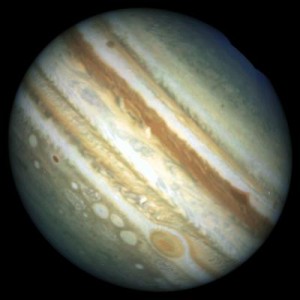Jupiter’s fast rotation makes it difficult to know when to look at it to see the Great Red Spot. But with Jupiter now easy to see in the pre-dawn sky above the Eastern horizon, now is the time to dust off your telescope and look for it. As for the why would you bother, the Great Red Spot is massive. You can brag to your friends that you have seen a storm which is so large it could easily swallow the Earth (and in fact not even notice).
The best thing to do is look at Jupiter around the time the Great Red Spot transits. For the non-astronomically jargon equipped, this simply means the Great Red Spot is crossing an imaginary line drawn from the North to the South pole of the planet.
The US based Sky & Telescope magazine has just made available a list of transit times for 2010 on it’s website. One thing to keep in mind is that the times are listed in Universal Time. You will need to covert these times to your location. For Eastern Australia (this includes Brisbane, Sydney, Canberra, and Melbourne), you just need to add ten hours to the time listed. This can get confusing if you aren’t used to it. The simplest way to deal with converting the time is to look at the number you get. If the number is bigger than 24, simply take 24 away. For instance, after if you have added your ten hours you end up with 28.45. Then take the 24 away. You are left with 4.45 or 4.45 am the next morning to look for Jupiter.
One thing to keep in mind, Jupiter’s Great Red Spot is a very pale salmon colour. That means it is (very) big but not obvious.
